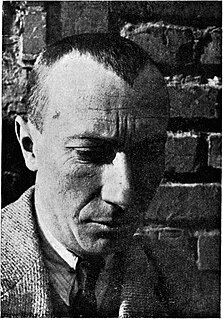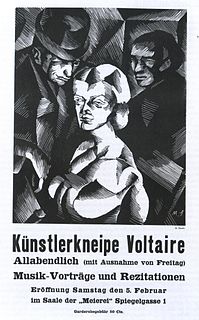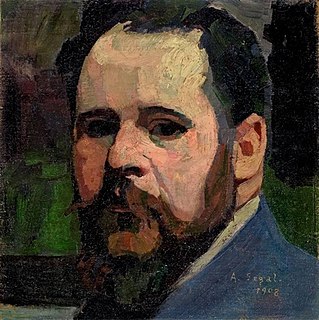
Dada or Dadaism was an art movement of the European avant-garde in the early 20th century, with early centres in Zürich, Switzerland, at the Cabaret Voltaire. New York Dada began c. 1915, and after 1920 Dada flourished in Paris. Dadaist activities lasted until the mid 1920s.

Tristan Tzara was a Romanian and French avant-garde poet, essayist and performance artist. Also active as a journalist, playwright, literary and art critic, composer and film director, he was known best for being one of the founders and central figures of the anti-establishment Dada movement. Under the influence of Adrian Maniu, the adolescent Tzara became interested in Symbolism and co-founded the magazine Simbolul with Ion Vinea and painter Marcel Janco.

Hans Peter Wilhelm Arp, better known as Jean Arp in English, was a German-French sculptor, painter, and poet. He was known as a Dadaist and an abstract artist.

Hugo Ball was a German author, poet, and essentially the founder of the Dada movement in European art in Zürich in 1916. Among other accomplishments, he was a pioneer in the development of sound poetry.

Cabaret Voltaire was an English music group formed in Sheffield in 1973 and initially composed of Stephen Mallinder, Richard H. Kirk, and Chris Watson. The group was named after the Cabaret Voltaire, the Zürich nightclub that served as a centre for the early Dada movement.

Cabaret Voltaire was the name of an artistic nightclub in Zürich, Switzerland. It was founded by Hugo Ball, with his companion Emmy Hennings, in the back room of Holländische Meierei, Spiegelgasse 1, on February 5, 1916, as a cabaret for artistic and political purposes. Other founding members were Marcel Janco, Richard Huelsenbeck, Tristan Tzara, and Sophie Taeuber-Arp and Jean Arp.

Carl Wilhelm Richard Hülsenbeck was a German writer, poet, and psychoanalyst born in Frankenau, Hessen-Nassau who was associated with the formation of the Dada movement.

Mark Divo is a Luxembourgeois conceptual artist and curator who organises large scale interactive art projects incorporating the work of underground artists. His own work involves painting, performance, photography, inhabited sculpture and installation.
Jan Theiler, alias Pastor Leumund is a German artist, musician and political activist.
Since the beginning of Dadaism in the Cabaret Voltaire, Zurich in 1916, many artists have experimented with extreme performance art as a critique of contemporary consumer culture. Some have used bodily fluids such as blood, faeces and urine. Other times they perform self-mutilation. Simulated (artificial) blood has also been used. In the 1960s and 1970s extreme performance was elevated to a movement with the Viennese actionists. In recent times there has been a resurgence in extreme performance as a response to the increasing alienation some artists feel in the face of today's technological advances.
Emmy Hennings was a poet and performing artist, founder of the Dadaist Cabaret Voltaire with her second husband Hugo Ball.

Sophie Henriette Gertrud Taeuber-Arp was a Swiss artist, painter, sculptor, textile designer, furniture and interior designer, architect, and dancer.
Lennie Lee is a South African conceptual artist who lives and works in London.

"Mittageisen" is a song by English rock band Siouxsie and the Banshees. It originally appeared on the band's 1978 debut album The Scream as "Metal Postcard (Mittageisen)"; the track was re-recorded in 1979, this time with the lyrics sung in German, and released as a single in West Germany with "Love in a Void" on the b-side. That September the song was given a UK release by record label Polydor as a double A-side single.

Electroboy is a Swiss model, author, conceptioner, graphic designer, electronic musician and music producer. He lives in Berlin. Electroboy produces electronic trash-pop and electroclash with simple, cheeky content based on a dadaistic philosophy. He also creates series of vector graphics to call up for more consumer responsibility and to promote a vegan lifestyle.

Arthur Segal was a Romanian artist and author.

Klänge is a book by the Russian expressionist artist Wassily Kandinsky. Published in an edition of 345 in Munich in late 1912, the work is a famous early example of an artist's book, containing both poems and woodcuts by the artist, forming two parallel strands, each involving a loose progression. One of three seminal books that Kandinsky published between 1911 and 1912 - the other two being Concerning the Spiritual in Art and Der Blaue Reiter Almanac that he edited with Franz Marc - Klänge was to have a direct and lasting influence on Expressionism, Dada and Russian Futurism.
[Kandinsky] began writing prose-poems, composing 38 altogether between 1908 and 1912. In 1913 these were published by Piper Verlag under the title Sounds, accompanied by colour and black-and-white woodcuts. in these Dadaistic poems, Kandinsky employs a method borrowed from young children's early attempts at speech; through constant repetition and babbling words are emptied of their meaning, so that only the pure sound remains. It is Kandinsky's aim to uncover this "pure sound" of language, the sound which "sets the soul vibrating."
"We fought for painting, but painting alone will not suffice. I had the idea of a synthetic book that removed half of the old, narrow conceptions, breaking down the walls between the arts.... and finally prove that the problem of art is not a problem of form but a problem of spiritual content." Kandinsky,

New York Dada was a regionalized extension of Dada, an artistic and cultural movement between the years 1913 and 1923. Usually considered to have been instigated by Marcel Duchamp's Fountain exhibited at the first exhibition of the Society of Independent Artists in 1917, and becoming a movement at the Cabaret Voltaire in February, 1916, in Zürich, the Dadaism as a loose network of artists spread across Europe and other countries, with New York becoming the primary center of Dada in the United States. The very word Dada is notoriously difficult to define and its origins are disputed, particularly amongst the Dadaists themselves.
Karawane is a composition for chorus and orchestra by the Finnish composer Esa-Pekka Salonen. The work was jointly commissioned by the Tonhalle Orchester Zürich, the Swedish Radio Symphony Orchestra, the New York Philharmonic with support from the philanthropist Marie-Josée Kravis, the Bamberg Symphony, and the Finnish Radio Symphony Orchestra. It was first performed by the Tonhalle Orchester Zürich and the Zürcher Sing-Akademie conducted by Lionel Bringuier in the Tonhalle, Zürich, on September 10, 2014. The piece is set to the eponymous poem by the German author and Dadaist Hugo Ball.
Cabaret Voltaire was an one-issue Dadaist art magazine which was published in May 1916 in Zurich, Switzerland. Its subtitle was eine Sammlung künstlerischer und literarischer Beiträge.













